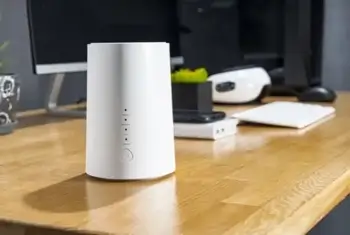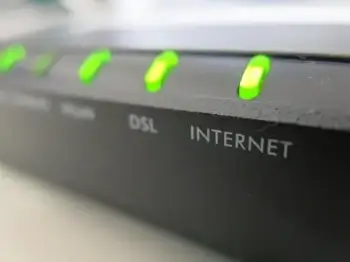What Is a Modem? Uses, Types, and Standards
Without modems, an Internet connection wouldn't be possible. Learn what a modem is, how to set up and troubleshoot general issues, and the different types of modems available for your connection.
What is a modem?
A modem is a device that allows computers and other devices to communicate with each other over telephone lines, cable lines, or satellite connections. The term is short for modulator-demodulator, and they are essential for connecting to the Internet and for sending and receiving data over networks.
In the early days of computing, they were used primarily to connect computers to remote terminals, allowing users to access information and services that were not available locally. Today, however, modems are used in a wide variety of applications, including Internet access, online gaming, telecommuting, and more.
Though types of modems function differently, they all share the same function: allowing devices to communicate with one another over a distance. Whether connecting to the Internet from your home or sending a file between two offices, these devices make it possible.
What is a modem used for?

Modems are used for connecting your home to your Internet service provider. Typically, they plug into your outlet, but they also can come in the form of dongles. They allow your computer, tablet, or other devices to access the Internet. Routers help distribute an Internet connection between devices on your home network. However, without a modem, connecting to the Internet itself is impossible.
How do modems work?
They work by converting digital signals into analog signals and vice versa, which allows computers and other devices to communicate.
When a computer wants to send data to another device, it converts it into a digital signal. It then sends this digital signal to the modem, which converts it into an analog signal. The modem sends the analog signal to the receiving device over the telephone line, cable line, or satellite connection.
When the receiving device receives the analog signal, it sends it to its modem, which converts it back into a digital signal. Finally, the receiving device gets the digital signal and can understand and use it.
The device uses a combination of hardware and software to perform the conversion process. The hardware part consists of two parts: a modulator, which converts the digital signal into an analog signal, and a demodulator, which converts the analog signal back into a digital signal. The software then manages and controls the communication between the modulator, the demodulator, and the device.
It's important to note that different modulator-demodulators use different technologies to accomplish this conversion process. For example, a dial-up modulator-demodulator uses a technique called frequency-shift keying (FSK) to convert digital signals into analog signals. In contrast, a cable modulator-demodulator uses a method called quadrature amplitude modulation (QAM) to accomplish the same thing.
Modems play a crucial role in allowing devices to communicate with each other over a distance. Through the conversion process, they make it possible for computers to connect to the Internet and to send and receive data over networks.
Types of modems
Numerous modems are available, each with its own features and capabilities. Some are designed for use in homes and small offices, while others are intended for use in large corporate networks. The most common types of modems include:
- Dial-up: These use phone lines to connect to the Internet. Dial-up modulator-demodulators have relatively slow speeds of up to 56 kbps, but rural areas still use them where broadband connections are unavailable.
- Cable: Cable modems work with the same type of coaxial cable used to deliver cable television. Cable modems and cable Internet are decently fast, with speeds of up to 100 Mbps. They work best in areas where cable television service is available.
- DSL: Digital subscriber line modems use telephone lines to connect to the Internet, though with a different technology than dial-up modulator-demodulators. They also operate faster, with speeds of up to 100 Mbps, and you can typically find them used in areas where DSL service is available.
- Fiber-optic: These use fiber-optic cables to connect to the Internet. With speeds up to 10 Gbps, fiber-optic is the fastest type of modulator-demodulator, typically used in areas where fiber-optic service is available.
- Wireless: Wireless modems, also known as WiFi modems, use radio waves to connect to the internet. They don't require any physical connection, which makes them convenient for most homes and offices.
- Satellite: Satellite modems use satellite connections to connect to the Internet. This makes them useful for remote or rural areas where other services are limited or unavailable.
There's no right or wrong one to use; it all depends on your needs. Consider the number of devices, cost, and Internet usage to determine the best modem for you.
Configurations on the device
How to set up modems
For a modem to work properly, the user must correctly set it up. Though configuration and setup varies depending on the type and model of the device, there are a few general steps that are typically followed when setting up a modem:
- Connect the modem. It must connect to a computer or a router using cables or wireless connections.
- Installing the software. After establishing the router connection, install the software that came with the modem or download it from the Internet.
- Configuration. Next, the modem's settings, such as the Internet Protocol (IP) address, subnet mask, and default gateway, must be established.
- Registration. This typically involves registering the device with the internet service provider (ISP) and obtaining an IP address.
- Testing the connection. After setup and registration, test the connection to ensure that the modem works correctly and that the Internet connection remains stable.
- Setting up the security. Finally, create a new password for your device and set up a firewall if desired.
It's essential to follow the instructions that come with the device or the instructions provided by the ISP to configure and set up the modem properly. Again, each brand and model requires slightly different setup steps, but the steps above work as a general guide.
How to troubleshoot modems
Even if you know how to configure and set up your modem correctly, you may still need help with issues. Lack of Internet, slow Internet connections, dropped connections, or limited connectivity can happen to anyone. If any of these issues arise, try troubleshooting yourself before calling someone or replacing your device.
Whenever you encounter an issue, first check the device's settings and configurations. It's possible that your device is misconfigured or malfunctioning, which could lead to problems like no Internet connection or limited connectivity. Try resetting the settings.

You can also check the cable connections and the status of the device's lights. Faulty equipment, such as the Ethernet cables or Ethernet ports used to connect the modem, can be problematic. Though you may need to replace the cables, it's easier to do that than replace the entire unit; check the cables to ensure all connections are secure.
If you use a router in conjunction with your modulator-demodulator, the router may be having issues. Try resetting your router and see if your Internet connection or speed improves. If problems persist after checking all the above, contact your Internet service provider or the manufacturer for further assistance.
Remember to maintain your modem and its firmware by regularly updating it when updates become available. Keep the modulator-demodulator clean, dust-free, and in a cool place, away from sources of interference like microwaves or cordless phones. Maintenance helps reduce the risk of encountering problems with your router.
Standards and protocols
Modems use a variety of standards and protocols to ensure that they can communicate with each other and with other devices. They include:
- V.92 is a standard that defines the capabilities of dial-up modems. It includes faster upload speeds, shorter connection times, and the ability to answer incoming online calls.
- DOCSIS, or Data Over Cable Service Interface Specification, defines the capabilities of cable modulator-demodulators. It allows them to communicate with the cable company's network and provides the power of high-speed Internet access.
- ATM, which stands for Asynchronous Transfer Mode, is a standard defining DSL modulator-demodulators' capabilities. It transmits data over telephone lines and allows for high-speed Internet access.
- PPPoE, or Point-to-Point Protocol over Ethernet, is a protocol that allows cable modulator-demodulators and DSL modulator-demodulators to connect to the Internet. Many Internet service providers use it to authenticate users and assign IP addresses.
- TCP/IP stands for Transmission Control Protocol/Internet Protocol. It's the standard set of protocols used to transmit data over networks such as the Internet.
Through these standards and protocols, modems communicate with each other and with other devices. They ensure that data sends accurately and quickly, giving users fast and reliable Internet access.
Frequently asked questions
Do I need a router or a modem?
In most cases, you need both. Each has an individual role in providing your Internet connection. However, many ISPs now offer modem-router combination units, meaning you only need a single unit for a complete Internet connection and network rather than standalone modems and routers.
What is the difference between a modem vs a router?
Though the two devices connect to provide you with Internet access, they have separate roles. Essentially, the router establishes the local area network (LAN) between devices in your home, and the modem links those devices to the Internet.
Are a modem and WiFi the same thing?
No, they are not the same things; a modem provides an Internet connection but is not a WiFi network.